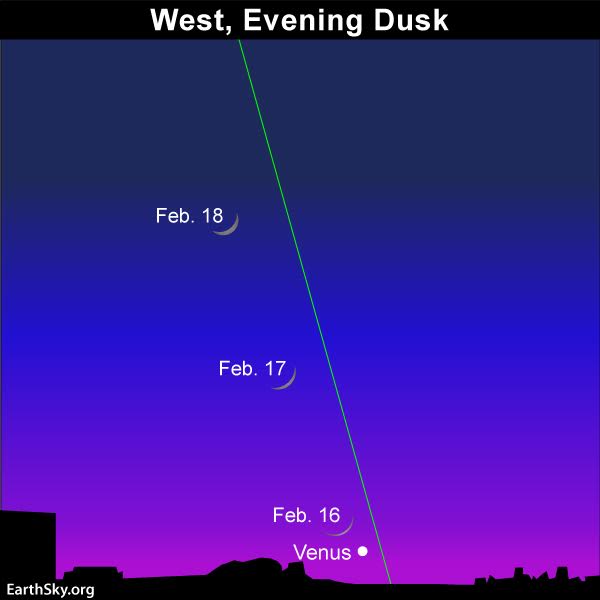Old moon on the morning of February 14, 2018, heading for a solar eclipse. David Rojas in Guatemala City, Guatemala, wrote: “Waning crescent moon, illuminated at approximately 1.84%, says goodbye early this morning minutes before dawn.” After this, the moon will shift over into the evening sky, to sweep past the returning planet Venus.
A moon at the new phase comes most nearly – for any particular month – to passing between the Earth and sun. The February 15, 2018, new moon at 9:05 p.m. UTC (translate UTC to your time) comes very nearly between the Earth and sun indeed, so very nearly that it causes a partial solar eclipse visible from the southern part of the globe. Read more about the February 15 solar eclipse.
This new moon will be noteworthy around the world for kicking off the 2018 Chinese New Year celebration. Read more about 2018’s Chinese New Year.
The February 15, 2018, new moon also brings to an end the longest lunar month of 2018. Its duration will have been 29 days, 18 hours, and 48 minutes.
Youngest possible lunar crescent, with the moon’s age being exactly zero when this photo was taken — at the instant of new moon – 07:14 UTC on July 8, 2013. Image by Thierry Legault. Visit his website.
New moons come once each month, as the moon orbits Earth. On the day of new moon – unless we’re viewing a total solar eclipse – we don’t see the new moon. That’s because a new moon rises when the sun rises. It sets when the sun sets. It crosses the sky with the sun during the day. Its fully illuminated face, or day side, is turned entirely away from us.
Modern techniques – telescopes, filters, photography – have made it possible to see the moon even at the instant it becomes new. That’s the case with Thierry Legault’s image, above, which he acquired in 2013. Read more about Thierry’s image here.
It’s only as the moon moves in orbit, as its lighted hemisphere begins to come into view from Earth, that we can see it in our sky. Then we see the moon in the west after sunset as a slim waxing crescent – what some call a young moon.

When you next see the moon, it’ll be a waxing crescent in your western sky after sunset. You might – or might not – catch the planet Venus near the horizon. Read more.
As the moon orbits Earth, it changes phase in an orderly way. Follow these links to understand the various phases of the moon.
Four keys to understanding moon phases
Where’s the moon? Waxing crescent
Where’s the moon? First quarter
Where’s the moon? Waxing gibbous
What’s special about a full moon?
Where’s the moon? Waning gibbous
Where’s the moon? Last quarter
Where’s the moon? Waning crescent
Where’s the moon? New phase
from EarthSky http://ift.tt/19T9DUm
Old moon on the morning of February 14, 2018, heading for a solar eclipse. David Rojas in Guatemala City, Guatemala, wrote: “Waning crescent moon, illuminated at approximately 1.84%, says goodbye early this morning minutes before dawn.” After this, the moon will shift over into the evening sky, to sweep past the returning planet Venus.
A moon at the new phase comes most nearly – for any particular month – to passing between the Earth and sun. The February 15, 2018, new moon at 9:05 p.m. UTC (translate UTC to your time) comes very nearly between the Earth and sun indeed, so very nearly that it causes a partial solar eclipse visible from the southern part of the globe. Read more about the February 15 solar eclipse.
This new moon will be noteworthy around the world for kicking off the 2018 Chinese New Year celebration. Read more about 2018’s Chinese New Year.
The February 15, 2018, new moon also brings to an end the longest lunar month of 2018. Its duration will have been 29 days, 18 hours, and 48 minutes.
Youngest possible lunar crescent, with the moon’s age being exactly zero when this photo was taken — at the instant of new moon – 07:14 UTC on July 8, 2013. Image by Thierry Legault. Visit his website.
New moons come once each month, as the moon orbits Earth. On the day of new moon – unless we’re viewing a total solar eclipse – we don’t see the new moon. That’s because a new moon rises when the sun rises. It sets when the sun sets. It crosses the sky with the sun during the day. Its fully illuminated face, or day side, is turned entirely away from us.
Modern techniques – telescopes, filters, photography – have made it possible to see the moon even at the instant it becomes new. That’s the case with Thierry Legault’s image, above, which he acquired in 2013. Read more about Thierry’s image here.
It’s only as the moon moves in orbit, as its lighted hemisphere begins to come into view from Earth, that we can see it in our sky. Then we see the moon in the west after sunset as a slim waxing crescent – what some call a young moon.

When you next see the moon, it’ll be a waxing crescent in your western sky after sunset. You might – or might not – catch the planet Venus near the horizon. Read more.
As the moon orbits Earth, it changes phase in an orderly way. Follow these links to understand the various phases of the moon.
Four keys to understanding moon phases
Where’s the moon? Waxing crescent
Where’s the moon? First quarter
Where’s the moon? Waxing gibbous
What’s special about a full moon?
Where’s the moon? Waning gibbous
Where’s the moon? Last quarter
Where’s the moon? Waning crescent
Where’s the moon? New phase
from EarthSky http://ift.tt/19T9DUm

Aucun commentaire:
Enregistrer un commentaire